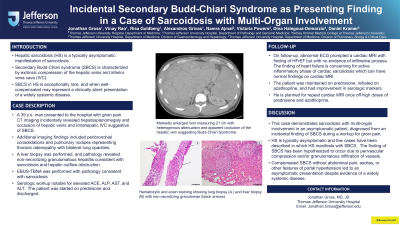Monday Poster Session
Category: Liver
P2560 - Incidental Secondary Budd-Chiari Syndrome as Presenting Finding in a Case of Sarcoidosis With Multi-Organ Involvement
Monday, October 23, 2023
10:30 AM - 4:15 PM PT
Location: Exhibit Hall

Has Audio
- JG
Jonathan Gross, MD, JD
Thomas Jefferson University Hospital
Philadelphia, PA
Presenting Author(s)
Jonathan Gross, MD, JD1, Vinay Rao, MD1, Risa Goldberg, MD1, Alexandros Grivas, MD1, Victoria Powers, BA2, Dina Halegoua-DeMarzio, MD1, Daniel Kramer, MD3, Namra Ajmal, MD1
1Thomas Jefferson University Hospital, Philadelphia, PA; 2Thomas Jefferson University, Philadelphia, PA; 3The Jane and Leonard Korman Respiratory Institute at Thomas Jefferson University, Philadelphia, PA
Introduction: Hepatic sarcoidosis (HS) is a typically asymptomatic manifestation of sarcoidosis. Secondary Budd-Chiari syndrome (SBCS) is characterized by extrinsic compression of the hepatic veins and inferior vena cava (IVC). SBCS in HS is exceptionally rare, and when well-compensated may represent a clinically silent presentation of a widely systemic disease.
Case Description/Methods: A 39-year-old man with history of complicated diverticulitis with hemicolectomy presented to the hospital with groin pain. CT imaging noted a right-sided inguinal hernia and hydrocele, and incidentally revealed hepatosplenomegaly and occlusion of hepatic veins and intrahepatic IVC suggestive of SBCS. Imaging included findings of peribronchial consolidations and pulmonary nodules, confirmed on CT chest as thoracic adenopathy with bilateral lung opacities. Follow up MRI confirmed marked narrowing of the intrahepatic IVC with compression secondary to enlarged caudate lobe with venous collaterals, consistent with SBCS. A liver biopsy was performed, and pathology revealed non-necrotizing granulomatous hepatitis consistent with sarcoidosis and hepatic venous outflow obstruction. Because of atypical features on CT chest, endobronchial ultrasound-guided transbronchial needle aspiration was performed with pathology revealing granulomatous inflammation. Endobronchial biopsy also noted non-necrotizing granulomas consistent with sarcoidosis. Serologic workup was notable for elevated ACE, ALP, AST, and ALT. The patient was started on prednisone and discharged.
On follow-up, abnormal ECG prompted a cardiac MRI significant for heart failure with reduced ejection fraction but no infiltrative process. The finding of heart failure is concerning for active inflammatory phase of cardiac sarcoidosis which can have normal findings on cardiac MRI. The patient was maintained on prednisone, initiated on azathioprine, and had improvement in serologic markers.
Discussion: This case demonstrates sarcoidosis with multi-organ involvement in an asymptomatic patient, diagnosed from an incidental finding of SBCS in a workup of groin pain. HS is typically asymptomatic; this coupled with compensated SBCS without abdominal pain, ascites, or other features of portal hypertension led to an asymptomatic presentation despite evidence of widely systemic disease. Moreover, few cases have been described in which HS manifests with SBCS. This finding has been hypothesized to occur due to perivascular compression and/or granulomatous infiltration of vessels.
Disclosures:
Jonathan Gross, MD, JD1, Vinay Rao, MD1, Risa Goldberg, MD1, Alexandros Grivas, MD1, Victoria Powers, BA2, Dina Halegoua-DeMarzio, MD1, Daniel Kramer, MD3, Namra Ajmal, MD1. P2560 - Incidental Secondary Budd-Chiari Syndrome as Presenting Finding in a Case of Sarcoidosis With Multi-Organ Involvement, ACG 2023 Annual Scientific Meeting Abstracts. Vancouver, BC, Canada: American College of Gastroenterology.
1Thomas Jefferson University Hospital, Philadelphia, PA; 2Thomas Jefferson University, Philadelphia, PA; 3The Jane and Leonard Korman Respiratory Institute at Thomas Jefferson University, Philadelphia, PA
Introduction: Hepatic sarcoidosis (HS) is a typically asymptomatic manifestation of sarcoidosis. Secondary Budd-Chiari syndrome (SBCS) is characterized by extrinsic compression of the hepatic veins and inferior vena cava (IVC). SBCS in HS is exceptionally rare, and when well-compensated may represent a clinically silent presentation of a widely systemic disease.
Case Description/Methods: A 39-year-old man with history of complicated diverticulitis with hemicolectomy presented to the hospital with groin pain. CT imaging noted a right-sided inguinal hernia and hydrocele, and incidentally revealed hepatosplenomegaly and occlusion of hepatic veins and intrahepatic IVC suggestive of SBCS. Imaging included findings of peribronchial consolidations and pulmonary nodules, confirmed on CT chest as thoracic adenopathy with bilateral lung opacities. Follow up MRI confirmed marked narrowing of the intrahepatic IVC with compression secondary to enlarged caudate lobe with venous collaterals, consistent with SBCS. A liver biopsy was performed, and pathology revealed non-necrotizing granulomatous hepatitis consistent with sarcoidosis and hepatic venous outflow obstruction. Because of atypical features on CT chest, endobronchial ultrasound-guided transbronchial needle aspiration was performed with pathology revealing granulomatous inflammation. Endobronchial biopsy also noted non-necrotizing granulomas consistent with sarcoidosis. Serologic workup was notable for elevated ACE, ALP, AST, and ALT. The patient was started on prednisone and discharged.
On follow-up, abnormal ECG prompted a cardiac MRI significant for heart failure with reduced ejection fraction but no infiltrative process. The finding of heart failure is concerning for active inflammatory phase of cardiac sarcoidosis which can have normal findings on cardiac MRI. The patient was maintained on prednisone, initiated on azathioprine, and had improvement in serologic markers.
Discussion: This case demonstrates sarcoidosis with multi-organ involvement in an asymptomatic patient, diagnosed from an incidental finding of SBCS in a workup of groin pain. HS is typically asymptomatic; this coupled with compensated SBCS without abdominal pain, ascites, or other features of portal hypertension led to an asymptomatic presentation despite evidence of widely systemic disease. Moreover, few cases have been described in which HS manifests with SBCS. This finding has been hypothesized to occur due to perivascular compression and/or granulomatous infiltration of vessels.
Disclosures:
Jonathan Gross indicated no relevant financial relationships.
Vinay Rao indicated no relevant financial relationships.
Risa Goldberg indicated no relevant financial relationships.
Alexandros Grivas indicated no relevant financial relationships.
Victoria Powers indicated no relevant financial relationships.
Dina Halegoua-DeMarzio: Pfizer – Advisory Committee/Board Member.
Daniel Kramer indicated no relevant financial relationships.
Namra Ajmal indicated no relevant financial relationships.
Jonathan Gross, MD, JD1, Vinay Rao, MD1, Risa Goldberg, MD1, Alexandros Grivas, MD1, Victoria Powers, BA2, Dina Halegoua-DeMarzio, MD1, Daniel Kramer, MD3, Namra Ajmal, MD1. P2560 - Incidental Secondary Budd-Chiari Syndrome as Presenting Finding in a Case of Sarcoidosis With Multi-Organ Involvement, ACG 2023 Annual Scientific Meeting Abstracts. Vancouver, BC, Canada: American College of Gastroenterology.
